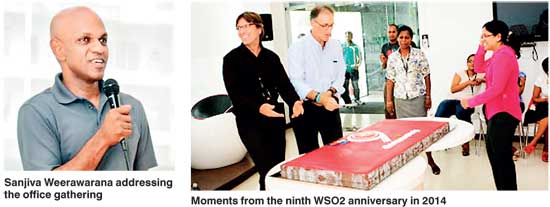Sunday Apr 20, 2025
Sunday Apr 20, 2025
Tuesday, 4 August 2015 01:05 - - {{hitsCtrl.values.hits}}
Ten years ago, Sanjiva Weerawarana had a problem: he had an idea for a company, but not enough money
An outsider would have been puzzled. Sanjiva technically didn’t need the money. A student of Royal College, he had moved to the USA for his PhD and started working for IBM in 1997. Technically, he had it made.
But he also had two more things: a massive passion for open source and a vision for a suite of middleware – an easily extensible software platform that let people build distributed applications. He also had stubborn, hard-nosed co-founder, Paul Fremantle, a product developer and author. They’d met over Paul’s book, somewhat creepily titled the ‘XML Files”.
So he quit IBM, setting up the framework for the business in Sri Lanka. Paul, wrapping up his work at IBM, joined shortly after. Sometime later, developers began to apply to a new company called Serendib Systems. Behind closed doors, the father of XML, James Clark, said he’d invest, but the name had to change. Soon the founders came up with a new name. It was catchy, very geeky, and it had the wonderful effect of making students, developers and business people all over Sri Lanka scratch their heads in puzzlement.

“WSO2?” they would ask. “What does that even mean?”
Today, on the cusp of its 10th anniversary, WSO2 is a thriving business
Not only has it been in action for a decade; its products run businesses all over the world, connecting massive enterprises and billions of customers on a daily basis. The Sri Lankan company is now involved in everything from the takeoff and landing of Boeing aircraft to the e-Government platforms of European countries. There are table-tennis tables, carom boards, open kitchens and foosball tables in the lobby. The ’20 people in an office’ tagline has become irrelevant; now there’s just under 500 people in six offices, three of them in Sri Lanka. Nobody still knows what the name means.
The name WSO2 comes from (but does not stand for) Web Services (WS) Oxygen (O2). Web services are what created the opportunity for this company to enter and challenge the middleware market. The O, with a pulse in it, is because of how the business model works - it’s about giving support, and life support often involves oxygen (O2).
Of course, going from an office with 20 people to a multi-national company with hundreds of employees doesn’t happen overnight. The first employees were largely from the University of Moratuwa; some of them had made their mark at the Lanka Software Foundation, a nonprofit set up by Sanjiva in 2003.

The first investors were James Clark, Paul Fremantle’s father and a mystery angel investor. The first product was WSO2 Tungsten; while it had nothing to do with the metal, it had everything to do with building applications on the Internet. Tungsten was followed by WSO2 Titanium, which would later become the famous WSO2 Enterprise Service Bus. Everything was open source – freely downloadable, easily modifiable, and completely contrary to the usual way of doing business in software.
By 2006, they needed more money. The fledgling finance team was ripping its collective hair out keeping things afloat. In May that year, Intel Capital invested 4 million dollars in WSO2, with perfect timing. Red Herring Asia called WSO2 one of the most promising private technology companies in Asia.
It’s almost tempting to say ‘and the rest is history’, but history generally records speeches, product reveals and profound statements made on stage; it tends to skip over days of coding and dedicated, passionate teams powering on through the nights. These were felt rather than written about.
Challenges arose, were met and overcome. Awards kept coming in. Gartner, the world’s most prestigious technology analyst firms, dubbed WSO2 a ‘visionary’ (and continues, to this day, to herald WSO2 as such). Developers found much to love in WSO2 software; it was, unlike others, completely open source, available to the community with no restrictions whatsoever.
In 2010, eBay decided to use WSO2 software. The world’s largest online marketplace tested WSO2 against a host of industry behemoths and decided that the Sri Lankan software outperformed everything else. By 2011 it was processing over $2,000 dollars per second and over a billion transactions a day. Today, it’s closer to 6 billion. eBay’s success validated WSO2: these Sri Lankan open source fanatics knew what they were doing. The company had a future.
Ten years later
WSO2’s products now run in a staggeringly diverse set of corporations - from international banks to airlines to automobile manufacturers to the makers of supercomputers. They’ve even become an integral part of the Apache Software Foundation’s open source community, pushing improvements, bug fixes, and updates to communities across the globe.
Its competition is the likes of IBM, Oracle and RedHat, all heavyweights in the software industry. Its reach is international: every year, over 1000 trips are made across the world by WSO2 developers, helping global firms implement systems that impact millions of  customers.
customers.
None of this is easy work. WSO2 succeeds partly due to a powerful, almost schizophrenic focus on the twin pillars of R&D and support. As it was all those years ago, competing with the juggernauts of the field still demands constant innovation and an absolute need to stay ahead of the curve.
Along the journey, offices have shifted, headcounts have multiplied, email inboxes have burst, and the name ‘WSO2’ has become synonymous with success. The two products have become 24 interconnecting pieces of middleware. Every year, Fortune 500 companies and analysts look to WSO2 products to solve problems – ranging from creating cloud environments to interconnecting enterprise software that deals with millions of people every day.
As it celebrates its 10th anniversary, one thing’s clear: a bunch of developers from Sri Lanka can take on the world – and win.
It’s been one amazing decade.